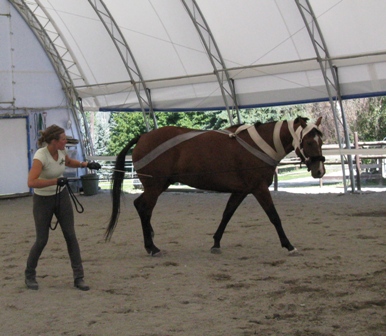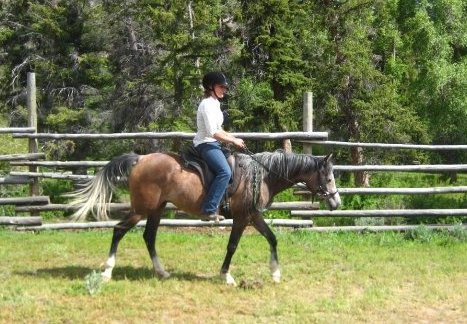Re-Educating and Starting Horses
Mandy has started young horses most of her life. While many have been Icelandic horses, Mandy spent many seasons starting Arabians, Quarter Horses, and Andalusian draft crosses under saddle, for cattle work as well as low level cross country at the Bitterroot Ranch. Developing a sound mind and body is a focus with each horse she starts.
Her methods are non-confrontational and focus on teaching the horse to learn to think rather than react. The corner-stone of the young horse's education begins with the Tellington TTouch Method, which improves horses confidence, balance, and ability to cooperate, and is then expanded using Connected Riding principles that teach horses self carriage and lateral flexibility.
Both methods draw from classical principles with an emphasis on reason and
understanding, mutual trust, and the importance of mental, emotional, and physical balance.
The Tellington TTouch Method aims to teach horses to learn, rather than only perform specific tasks through repetition. Every exercise looks to put the horse in a posture we would want under saddle, without bracing, tension, or fear.
Young horses learn to navigate plastic and other scary obstacles of all kinds in a non-confrontational way, looking to make things easier for the horses to understand, in small steps if necessary, rather than simply increase pressure to push them through it.
Ground exercises are cornerstone to the training process; incorporating Tellington TTouch groundwork to improve; focus, balance, and straightness; as well as Connected Riding ground exercises, that are designed to teach horses how they can release through the body and carry themselves in a more “correct” and effective way, while learning to be balanced, relaxed, and supple. The Connected groundwork has proven to be incredibly effective in influencing gaits, reducing stiffness, and bio-mechanically preparing horses to carry the weight of the rider.
Horses are ground driven extensively and learn the aids before even having a rider in the saddle. Ground driving takes place in the arena, out on the trail, and along the road to expose youngsters to as many different obstacles as possible.
Horses are prepared for mounting by being ponied, and walking between people standing on blocks. These steps are taken as slowly as necessary for each individual horse. As a result, the horses do not buck or explode the first time they are mounted.
Mandy takes a limited number of outside horses into training each year.
For information on availability and rates please send an inquiry.

Teaching "Ringo" a 4 year old Warmblood to telescope and accept contact on his head.

"To watch Mandy assess a situation, listen carefully to people and observe behavior, it's clear why she achieves the successes she does. She's a master at incorporating all the small steps and nuances into a cohesive package to attain the overall goal. She is an incredible woman with a gentle sense of humor and to work with her you'll greatly enhance your skills and your horse's life."
Tracy (Charlottesville, VA)
After a horse has been mounted, ground exercises are continued, as is bodywork to ensure a horse is not holding excessive tension. Connected ground work helps increase a horse's understanding laterally, with exercises that are taken under saddle. Gaits are not emphasized until a horse is strong enough to really carry the rider easily, often after months of regular riding, and can truly understand basic transitions.
Once horses have progressed through the basic fundamentals, the gaits may be developed. Emphasizing lateral flexibility and connection through the body, horses are brought along slowly with a combination of arena work, and riding on the trail where dogs, logging trucks, and bicycles are the norm.
With each horse there is an emphasis on mentalWorking an Icelandic stallion in hand to achieve better impulsion and release through the back and neck.

"Witu", an initially difficult and nervous Arabian mare, relaxed and confident her first time under saddle.
Riding an over sensitive Appendix Quarter Horse with a neck ring to help him find his own balance and relax.
